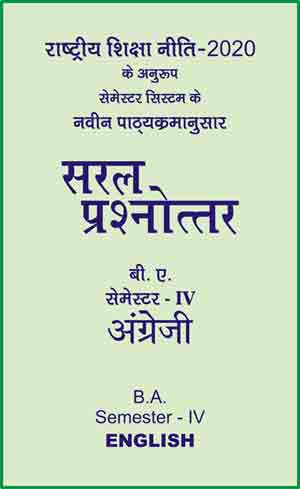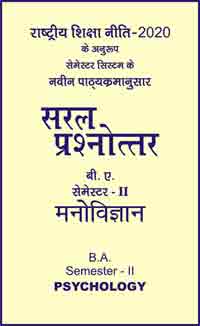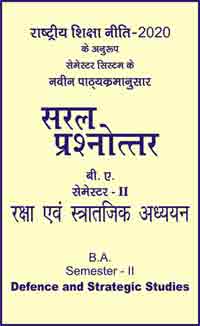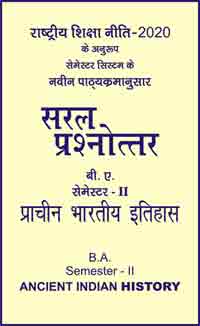|
बी ए - एम ए >> बीए सेमेस्टर-4 अंग्रेजी बीए सेमेस्टर-4 अंग्रेजीसरल प्रश्नोत्तर समूह
|
5 पाठक हैं |
|||||||
बीए सेमेस्टर-4 अंग्रेजी - सरल प्रश्नोत्तर
Important Facts to Remember
The Train has Reached Amritsar translated from the original text, Amritsar Aagaya is a wellknown story by Bhishma Sahni. It presents the scenario of the Indo-Pak partition. After the announcement of Partition, the author has made a successful attempt in realizing the spirit of communalism in his story of "The Train has Reached Amritsar". The communalism that was burning in the hearts of the people at the time of Partition came in the form of riots. In the story, the author has made a close observation how a train coming out of a city in present-day Pakistan through different stations to reach Amritsar is faced with tensions and controversies during this train journey by small incidents. As the train moves forward, the tension increases. The ridicule and abuse of Hindu travellers by some Pathan travellers is prominently featured in this story. The tragedy of Partition affected millions of people not only on the emotional and ideological plane but also on psychological and spiritual level.
'Literature is the mirror of society' and the incidents happened in society have better reflected in the works of literature. The partition of India on the basis of religion is the most noteworthy incident of the twentieth century which verily became the focal literary theme for both the Indian and Pakistani writers. August, 1947 symbolizes the end of the British Colonialism from the Indian subcontinent. The departure of the British from the Indian subcontinent led to the creation of two independent states based on religion. The supposition states that, the Hindus and Muslims cannot live together as one nation since both have distinct social, cultural and religious identities. In August, 1947 when the British government announced the division of the subcontinent into two separate nations for Hindus and Muslims the Subcontinent crooked into a diabolical and devastated region. All people of the united India were directly or indirectly affected by the event of partition. This was the darkest event in the history of the Indian subcontinent. Wickedness, violence, communal thoughts and pure evil exploded into powerful mass that came in its course. The Indian independence movement, the partition of India and its aftermaths have very aptly represented in the various genres of literature especially in fictions of various partition novelists.
The Indian English literature especially the fiction deals with the partition, politics of partition and several other themes. Literature which depicts the human cost of the independence and partition of India consist of magnitude of works, the most celebrated among them are: Raja Rao's Kanthapura (1938), R. K. Narayan's Waiting for Mahatma (1956), Kamala Markandaya's Some Inner Fury (1956), Mukul Keshwan's Looking through the Glass (1995), Khushwant Singh's Train to Pakistan (1956), In Hindi literature the list of the writers and novelists who has dealt with the theme of partition and politics is a lot extended. They can be divided into two categories- those who dealt with the factors responsible for partition, and those who dealt with event itself. Bhisham Sahni, the renowned Hindi author and playwright, is also one of them who chose partition of India and its impacts on various people and society as a theme for his short story "Amritsar Aa Gaya Hai".
The short story Amritsar Aa Gaya Hai is set during the Partition of India. The Muslim majority regions of Punjab and Bengal were divided into West Punjab and East Bengal with formation of West and East Pakistan, India was in the middle of the two. This resulted in a massive and violent migration of the inhabitants across the divided line. Muslims moved to Pakistan whereas Sikhs and Hindus moved to India with the prospects of peaceful and better livelihood, with their own religious as well as ethnic identities. The situation of partition was too critical that both Hindus and Muslims show the way to mass scale migration, crimes of unprecedented violence, murders, rapes and brutality. In the story Amritsar Aa Gaya Hai a group of refugees are travelling in a train from what has now become Pakistan towards Amritsar, the first border town in India, and the horrors and destruction they witness on the journey.
The riots were the natural results of partition. A neglected spark during partition turned into huge fires and gutted large cities into its compass. The story depicts a state of madness in people which made them act insanely during partition and it is obvious that if a man drinks the poison of communalism and hatred, he will naturally do such insane and lunatic acts. Even the weakest one could turn obnoxious, challenging and fatal provided gets the chance. The fiction serves an opportunity to understand how common people during the predicament of partition suffered. It shows the plight of common people who suffered during the communal riots and brutalities of partition and revealing the disgust and anger of the innocent people, who were directly or indirectly victimized during this period.
Stories like We Have Arrived in Amritsar succeed because they show that violence doesn't discriminate. The Hindus and the Muslims, Indians and . Pakistanis, are all interchangeable in the most memorable Partition stories. We look at the murdered or raped figure -- and feel that the victim could have been one of our own. It is a pitiful representation of tragic accounts of partition which was an episode of enormous intensity that affected the normal lives of millions of people. The faith in humanity was at its lowest position in those days. No one Hindu, Muslim or Sikh was sure about their own safety and security.
Partition related short stories magnify the riots, arson, killing, looting abduction and rape during the Partition. These stories reflect comprehensively in all its totality, reality, and variety of human suffering. As Alok Bhalla mentions about the writers of Partition stories: "They (the partition stories) are rather, witnesses to a period in which we fell out of a human world of languages, customs, rituals and prayers into a bestial world of hatred, rage, selfinterest and frenzy". The writers of these stories frame the events in a variety of ways and read them according to their own sense of the multireligious and multicultural past of the Indian subcontinent.
Partition of India as developed in the story of The Train Has Reached Amritsar was to resolve the confrontation between the Hindus and the Muslims. About six billion people including women, men and children lost their life in this crusade. About 1.5 billion people were dislodged and forced to rehabilitate in their safe zone according to their population 2 ratio. This had been an awful experience for both the communities resulted in the Indo-Pak partition.
This story also explains the process of partition as a hurriedly drawn exercise in which the crux of mental agony and unwanted rumours spread among both the communities. Ultimately both the communities were at daggers drawn. However the reason of this confrontation was not known to the people of both the communities.
The characters mentioned in this story either Pathan, Dubla Babu and other travellers of the train belong to middle class society and seem to be ignorant but exploited. None of them could understand the purpose of the creation of Pakistan. Most of them were found indulged in irrelevant discussion whether Jinnah sahib will leave Bombay and be settled in Pakistan but some of them disagreed to this superfluous discussion. This sort of political sharing is nothing but a voice of the disgruntled society where peace appears to be a distant dream and the high-ups of the society enjoy their mirthful lives.
The whole story depicts the psychological bent of mind developed due to inhumane behaviour of the inhabitants of United India. When the train moves through the passage of Muslim dominated area in the newly created Pakistan, the Hindus are very shaky and the Muslims are behaving like warriors; on the contrary when the train passes through the Hindu dominated area fallen in India, the Hindus behave like warriors and the Muslims look like scapegoats.
Above all this story presents a true picture of communal devastation during the period of partition. The characters are well drawn and they represent lively picture of Indian population in undivided India with the cult of Hindu-Muslim ethos. The religion is not brought to condemn the nation in this story but the social fabric is the culminating point in shaping this story. Sahni is brilliant when it comes to gauging human emotions, particularly in a conflict situation and weaving it with the larger scenario of the country. No one has captured people's internal conflicts better than him. He mastered the art of putting people right in the middle of a conflict and then telling the story through them. The writer is disgusted and disappointed with the violence and harrow of partition that he portrayed the realistic accounts of violence of partition very artistically without taking any side and blamed both the communities and nations equally.
|
|||||














